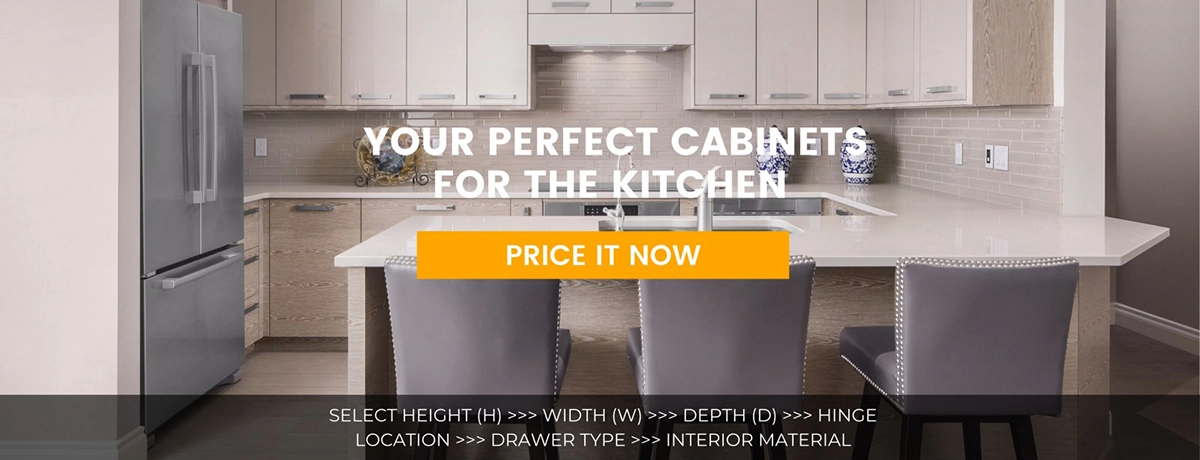Plywood Kitchen Cabinets - a Comprehensive Overview
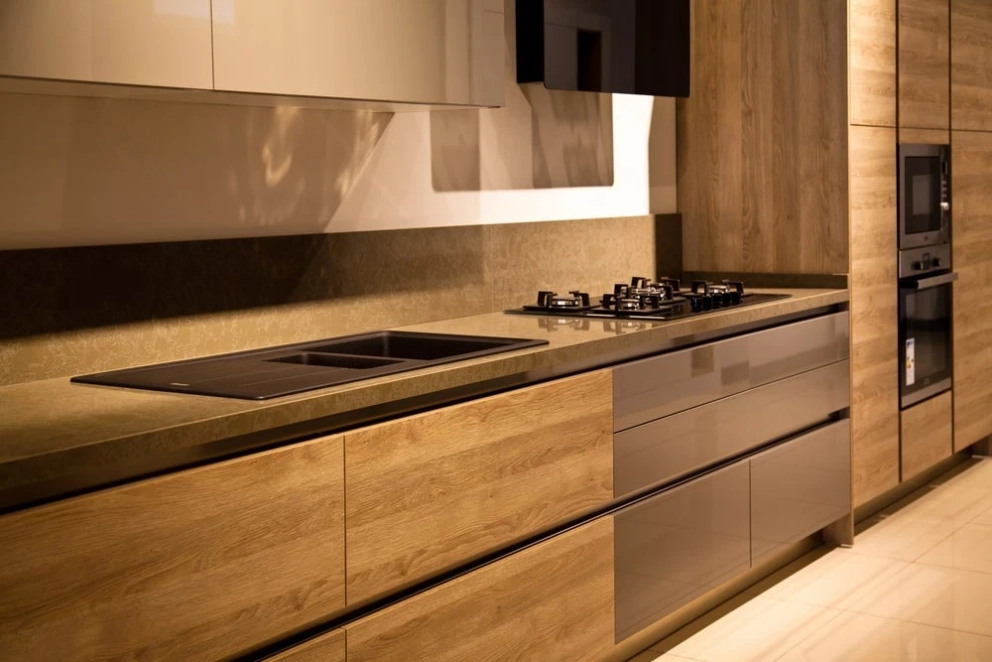
When you are going to replace your cabinets, it is important to consider many parameters, such as the kitchen layout as well as the material from which they are made. The layout you choose is responsible so that the new cabinets fit the size and do not spoil the ergonomics. While cabinet material is important to ensure safety in the kitchen, and to install units that will remain beautiful for years to come.
From solid wood to chipboard, there are many materials available on the kitchen market today to suit every budget. One of the most popular options is kitchen cabinets made of plywood. They can be produced with treated or exposed edges. Plywood allows you to cover the cabinets with a variety of different finishes - from stain to polyurethane. So modern plywood kitchen cabinets may not look any different from other units you've looked at.
However, you need to understand the specifics of plywood before ordering cupboards for your kitchen. This Cut2Size blog is all about plywood kitchen cabinets in Canada. We will start with the plywood grades and what types of plywood are suitable for kitchen assembles. We will talk about what parts of cabinetry are more often made of plywood and why, how plywood interacts with different finishes, as well as the cost of plywood cabinets.
Is plywood good for kitchen cabinets?

Among the various options available, plywood for kitchen cabinets has emerged as a popular choice for modern kitchen cabinets. In this section, we'll explore the ins and outs of plywood for kitchen cabinets, covering everything from thickness and grades to assembly options and design considerations.
Grades of plywood for cabinets
When selecting plywood for your kitchen cabinets, it's essential to consider the grade because it determines the quality and appearance of the cabinets. Different plywood grades vary in terms of the number of defects, such as knots or voids, and the overall smoothness of the surface. By choosing the appropriate grade, you can ensure that your cabinets meet both your aesthetic preferences and functional requirements, ultimately impacting the overall look and performance of your kitchen. Plywood grades range from A to D, with A being the highest quality and D being the lowest. For kitchen cabinets, it's advisable to go for grade A or B plywood, as they have fewer imperfections and provide better aesthetics and durability.
Why does a kitchen cabinet's plywood thickness matter?
The thickness of kitchen cabinet plywood matters for several crucial reasons. Firstly, it directly impacts the cabinet's structural integrity and weight-bearing capacity, with thicker plywood providing better support for heavy dishes, appliances, and countertop materials. Secondly, it affects the cabinet's resistance to warping and sagging over time, as thicker plywood is less prone to deformation due to changes in temperature and humidity. Lastly, the thickness of the plywood also influences the overall durability and longevity of the cabinets, ensuring they withstand the wear and tear of daily kitchen use for years to come.
Let's talk about one of the fundamental aspects of plywood thickness for cabinets: the thickness of plywood for cabinets comes in varying options. Cabinets with 1/2-inch and 3/4-inch plywood are the most common choices for cabinet construction.
One of the dilemmas many homeowners face is whether to opt for cabinets made of 1/2-inch or 3/4-inch plywood. The choice often depends on budget constraints and personal preferences.
- 1/2-inch plywood is a suitable choice for ready-to-assemble (RTA) cabinets, particularly for wall cabinets and upper cabinets where weight-bearing capacity isn't as critical.
- 3/4-inch plywood, on the other hand, is the preferred option for base cabinets and other areas where sturdiness and durability are paramount.
Cabinet structure features
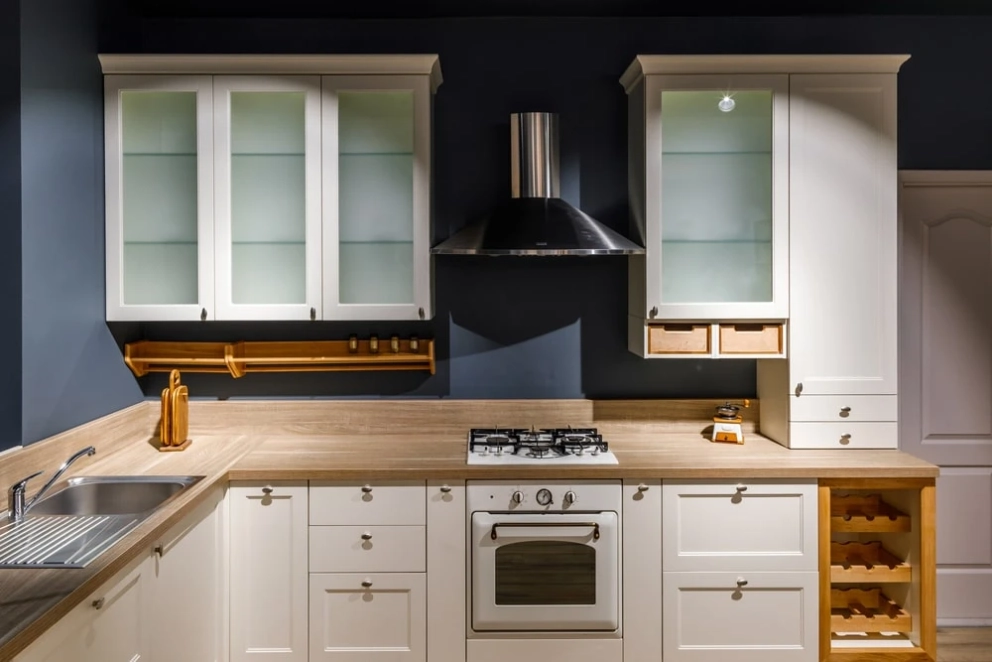
Plywood upper and base cabinets serve distinct functions in a kitchen design. Plywood base cabinets are positioned closer to the floor and are built to withstand heavier loads, making them suitable for storing pots, pans, and kitchen appliances. They provide essential storage and support for countertops. In contrast, plywood upper cabinets are mounted on the wall, offering storage space for dishes, glassware, and smaller items. While both types of cabinets can be made from plywood for their durability, the specific design and placement considerations make them tailored to their respective roles within the kitchen layout.
- Plywood box kitchen cabinets
The cabinet box, or carcass, is the framework that supports the cabinet doors and drawers. Plywood box kitchen cabinets offer excellent stability and can be customized to meet your specific storage needs. The box itself can be supplemented with inner shelves or drawers, equipped with lazy Susan or other pull-out mechanisms for cabinets.
- Plywood doors for kitchen cabinets
In addition to cabinet boxes, plywood is often used for cabinet doors. Plywood kitchen cupboard doors can be sleek and minimalist, offering a clean and contemporary look to your kitchen. Proper finishing and sealing are essential to protect the plywood kitchen cabinet doors from moisture and wear.
- Plywood backing for kitchen cabinets
The backing material used in your kitchen cabinets is another crucial consideration. While some cabinets feature solid plywood backing, others may utilize a thinner plywood or particleboard. Opting for solid plywood backing enhances the overall structural integrity of your cabinets, ensuring they withstand the test of time.
- Exposed plywood edge cabinets
For a contemporary and industrial look, some homeowners opt for exposed-edge plywood cabinets. These cabinets showcase the edges of the plywood, adding a unique design element to your kitchen. It's essential to ensure the exposed edges are properly finished and sealed to prevent moisture penetration and maintain the cabinet's integrity.
- Plywood kitchen countertop
Plywood kitchen countertops are gaining popularity for their affordability, versatility, and natural appeal. One of the primary advantages of using plywood for kitchen countertops is its ability to adapt to various kitchen styles. Plywood can be customized with a variety of finishes, including laminates, veneers, or even a clear coat to showcase the wood's natural beauty. Additionally, plywood countertops are relatively easy to install and can accommodate sinks and appliances seamlessly.
- Plywood kitchen island
As well as plywood being a durable and sturdy material, a kitchen island made from plywood offers a range of practical and aesthetic features. It can withstand daily use and occasional wear. Additionally, plywood can be easily customized with a variety of finishes, such as paint, veneers, or stains, to match your preferred aesthetic. Plywood's versatility allows for various design options for kitchen islands, including different shapes, sizes, and configurations, catering to the specific layout and needs of your kitchen. Moreover, plywood kitchen islands often include built-in storage solutions, such as cabinets, drawers, or shelves, providing ample space for utensils, cookware, or pantry items.
Ready to assemble plywood kitchen cabinets
RTA plywood kitchen cabinets are an increasingly popular option for homeowners looking for cost-effective and convenient solutions for a modular kitchen from plywood. RTA cabinets are typically crafted from plywood panels, which ensures their durability and longevity in the kitchen environment. These cabinets are designed to be easy to assemble and install, making them a practical choice for DIY enthusiasts or those on a budget. Many RTA cabinets are constructed using 3/4-inch plywood, providing a sturdy and reliable option for budget-conscious homeowners. RTA plywood kitchen cabinets offer a wide range of styles and finishes, allowing homeowners to achieve the aesthetic they desire without compromising on quality.
Types of plywood for kitchen cabinets
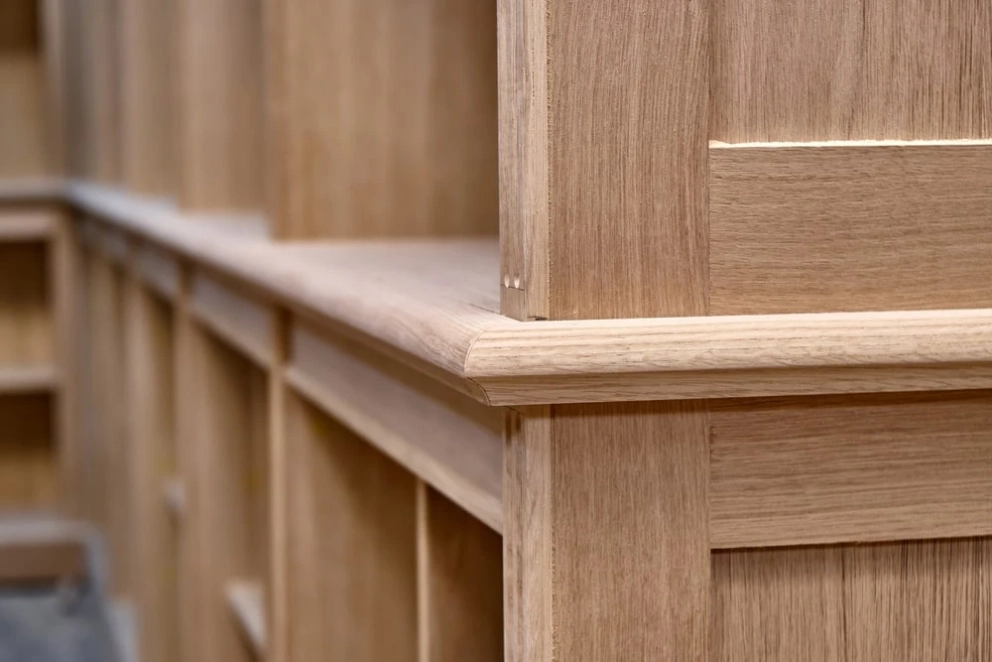
As a versatile and durable wood product, plywood offers a wide range of options to cater to different styles and budgets. In this section, we'll delve into what plywood is used for cabinets. We’ll talk about the various types of plywood to use for cabinets, from dependable solid plywood to exotic marine plywood. You’ll be able to find the best plywood for kitchen cabinets or decide whether to opt for custom plywood kitchen cabinets.
- Solid plywood kitchen cabinets
Solid plywood sheets for kitchen cabinets are a top choice for kitchen cabinets due to their exceptional strength and stability. These cabinets consist of plywood panels that are constructed from layers of solid wood veneers, ensuring uniformity and durability. Solid plywood cabinets are known for their longevity and resistance to warping, making them a reliable option for any kitchen.
- Veneer core plywood for cabinets
Veneer core plywood for kitchen cabinets is another popular choice for kitchen cabinets. It is constructed with a core made from layers of thinly sliced wood veneers, bonded together with adhesive. This type of plywood is prized for its affordability, making it an excellent option for budget-conscious homeowners while still providing decent strength and stability.
- Birch plywood cabinets
Birch plywood kitchen cabinets are a favourite among cabinet makers for their light, uniform colour and fine grain pattern. It's a versatile choice that complements a variety of kitchen styles, from contemporary to traditional. Birch plywood cabinets offer a smooth and consistent surface for painting or staining, allowing for customization to match your kitchen's aesthetic.
- Pine plywood for cabinets
Pine plywood is valued for its rustic charm and affordability. It has a distinctive, warm appearance with prominent grain patterns that add character to your kitchen. Pine plywood cabinets can be stained to enhance their natural beauty or painted to suit your design preferences.
- Maple plywood for cabinets
Maple plywood kitchen cabinets are celebrated for their fine texture and even grain, making them an excellent choice for both modern and classic kitchen designs. Its pale, creamy colour allows for a wide range of finishes, from natural stains that highlight the wood's beauty to painted surfaces that match your kitchen's colour scheme.
- Oak plywood for cabinets
Oak plywood offers a timeless and traditional look for kitchen cabinets. Its prominent grain pattern and durability make it a suitable choice for busy kitchens. Oak cabinets can be stained to reveal the wood's natural richness or painted for a more contemporary appearance.
- Poplar plywood for cabinets
Poplar plywood is often chosen for its light colour and smooth surface, making it a versatile option for kitchen cabinets. While it might not have the distinctive grain patterns of other woods, it provides a neutral canvas for various finishes and styles.
- Walnut plywood cabinets
For those seeking a touch of luxury in their kitchen, walnut plywood cabinets are an excellent choice. Walnut's rich, dark brown colour and striking grain create a sophisticated and elegant look. These cabinets are often selected by homeowners who want their kitchen to make a statement.
- Hickory plywood for cabinets
Hickory plywood offers a unique blend of strength and character. With its contrasting light and dark streaks, hickory plywood cabinets bring a rustic and natural feel to your kitchen. This wood choice is perfect for those who want their kitchen to exude warmth and personality.
- Marine plywood kitchen cabinets
If you're looking for the ultimate in durability and water resistance, marine plywood for kitchen cabinets is the answer. Typically used for boat construction, marine plywood is an excellent choice for kitchens prone to moisture. These cabinets can withstand the test of time and the challenges of a busy kitchen.
Each type of plywood offers unique characteristics and aesthetics, so consider your preferences, budget, and the demands of your kitchen when making your selection. Whether you opt for the classic appeal of birch or the opulence of walnut, there's a plywood type that's perfect for your kitchen cabinets.
Plywood kitchen cabinets cost
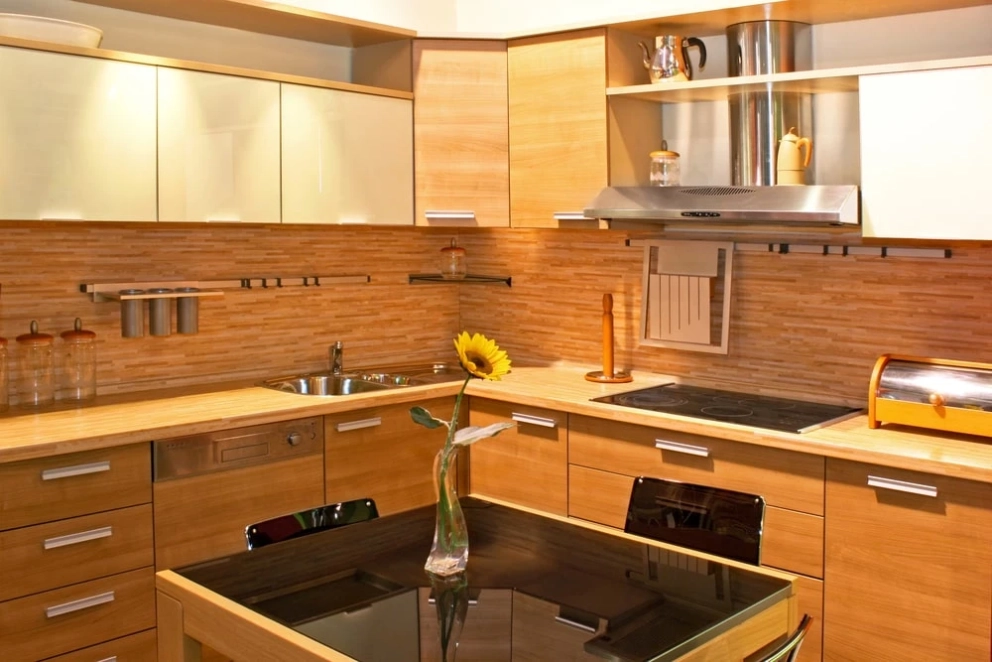
The cost of plywood kitchen cupboards or cabinets can vary widely depending on the factors mentioned above, but here's a general plywood kitchen cabinet price range to give you an idea:
- Budget-friendly kitchen cabinets from plywood: for small spaces, you can expect to spend anywhere from CAD $2,000 to CAD $6,000. This includes materials and installation.
- Mid-range cabinetry: For a mid-sized kitchen with upgraded features and a mix of solid plywood and veneer core plywood, the cost can range from CAD $6,000 to CAD $15,000.
- High-end kitchen: If you're aiming for a large, luxurious kitchen with premium plywood cabinets, intricate designs, and custom finishes, be prepared to invest anywhere from CAD $15,000 to CAD $40,000 or more.
Keep in mind that the cost of plywood kitchen cabinets are approximate figures and can vary significantly depending on your kitchen specific, the materials and finishes you choose, and the complexity of the project.
Plywood kitchen cabinets pros and cons
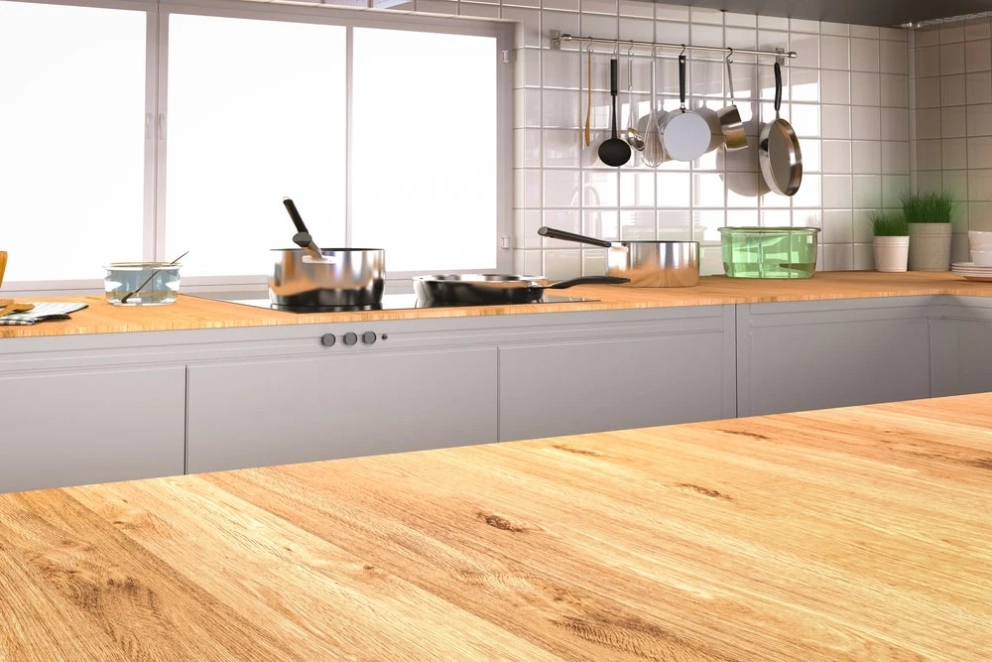
When considering cabinetry options for your kitchen remodel, it's essential to weigh the advantages and disadvantages. In this comprehensive guide, we will explore the pros and cons of all-plywood kitchen cabinets, providing you with valuable insights to help you make an informed decision about choosing a plywood cabinet in the kitchen.
| Aspect | Pros | Cons |
| Strength and durability | - Highly durable and resistant to warping. - Resistant to moisture damage. - Withstands wear and tear. | - Generally, more expensive than some alternatives. - Heavier and may require sturdy support. - Prone to damage from pests if not treated properly. |
| Aesthetics | - Natural wood grain appearance. - Suitable for various finishes. | - Limited variety in terms of aesthetics. |
| Customization | - Easily customizable with stains or paints. - Easily processed to produce custom-sized cabinets. | - May require additional finishing steps for the desired appearance. |
| Cost | - Moderate to high-cost option. | - Premium solid plywood cabinets can be expensive. |
| Moisture resistance | - Resistant to moisture damage. | May easily get damaged if proper edge treatment is not applied. |
| Environmental impact | - Considered eco-friendly when using sustainably sourced wood. | - May contain adhesives that include harmful components. |
| Maintenance | - Can be refinished multiple times. | - Requires periodic sealing or refinishing to keep it in good condition. |
When it comes to choosing the right material for your kitchen cabinets, the options can be overwhelming. Two popular contenders in the world of cabinetry are MDF vs. plywood for kitchen cabinets. Each material has its unique characteristics, making it important to consider what suits your needs best. Additionally, you might find yourself contemplating the merits of plywood vs. melamine cabinets. The choice between plywood and particle board cabinets is another crucial decision, as is the consideration of plywood vs. hardwood cabinets. In this comprehensive guide, we'll break down these kitchen cabinet materials, helping you make an informed choice for your kitchen renovation or remodel.
- Plywood vs. MDF for kitchen cabinets
MDF (Medium-Density Fiberboard) and plywood are both common materials used for kitchen cabinets. While plywood is constructed from layers of real wood veneers, MDF is made from compressed wood fibres and resin, resulting in a denser and more stable composition. MDF cabinets offer a smooth and consistent surface that's ideal for painted finishes, but they may be more susceptible to moisture damage compared to plywood, which is more water-resistant.
On the other hand, plywood cabinets, made from layers of wood veneers, are prized for their durability and resistance to warping. When it comes to plywood or MDF cabinets, the choice often depends on your aesthetic preferences and budget.
- Melamine cabinets vs. plywood cabinets
Melamine cabinets are known for their affordability and versatility. They are constructed using particleboard or MDF panels coated with a melamine finish, available in a wide range of colours and patterns. Plywood cabinets, while generally more expensive, offer a natural wood grain appearance and greater durability. When deciding between melamine vs. plywood cabinets, consider your budget and the desired aesthetic for your kitchen.
- Particle board vs. plywood cabinets
Particle board cabinets are composed of compressed wood particles held together with adhesive. While they are the most economical option, they are more susceptible to moisture damage. Plywood cabinets, conversely, are highly durable and resistant to warping and moisture. When comparing particle board vs. plywood cabinets, keep in mind the kitchen's environment and your long-term investment.
- Plywood vs. hardwood cabinets
The choice between plywood and hardwood cabinets often boils down to budget and aesthetics. Plywood cabinets, constructed from layers of wood veneers, offer a balance of durability and cost-effectiveness. Hardwood cabinets, crafted entirely from solid wood, provide an elegant and timeless appearance but come at a premium cost. When considering plywood vs. hardwood cabinets, assess your design preferences and budget constraints.
In the end, the decision of MDF vs. plywood for kitchen cabinets, melamine vs. plywood, or any other material mentioned, hinges on your unique needs and priorities. Whether you prioritize aesthetics, durability, or cost-effectiveness, understanding the characteristics and pros and cons of each material will help you make an informed choice that aligns with your kitchen remodelling goals.
Can you paint plywood cabinets?
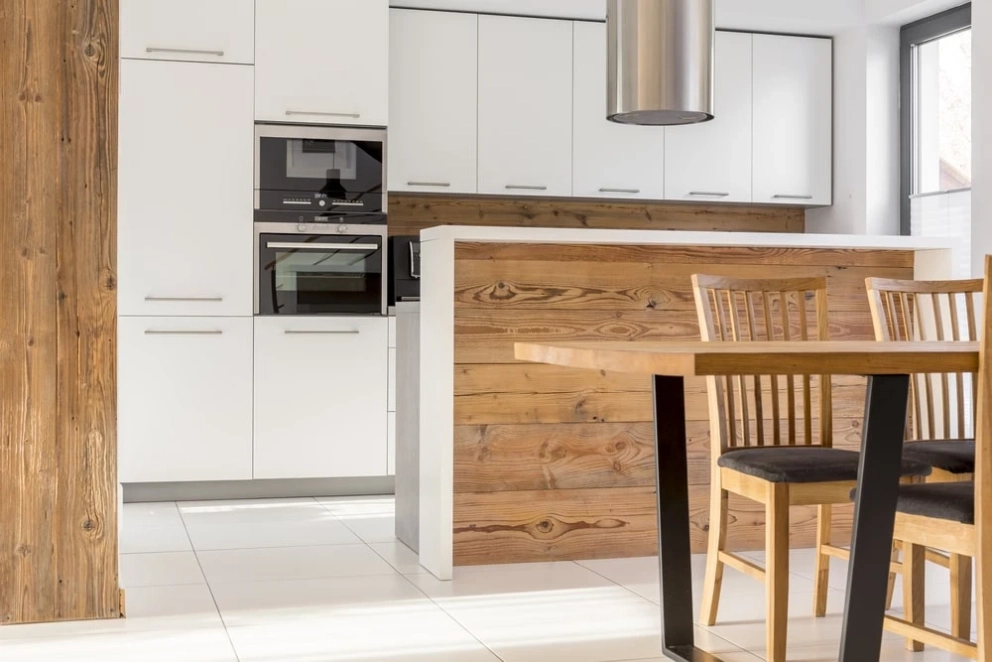
You can indeed paint your plywood kitchen cabinets to create a design with a fresh and updated appearance. Refinishing or repainting a plywood cabinet design for the kitchen can be a cost-effective way to transform your kitchen without the need for a complete cabinet replacement. Whether you aim to protect exposed edges or just refresh your kitchen look, refinishing plywood cabinets allows for a wide range of design possibilities.
To achieve the best results when painting plywood cabinets, it's essential to follow a few key steps. Firstly, ensure that you have paintable plywood for cabinets. This means that the plywood surfaces are clean and free of dust and grease. Sanding the cabinets lightly can help create a smoother surface for the paint for plywood cabinets to adhere to. Applying a high-quality primer specifically designed for unfinished plywood kitchen cabinets is crucial, as it promotes paint adhesion and prevents the wood grain from bleeding through. Once the primer is dry, you can choose your desired paint colour and finish plywood for the cabinets. Whether you opt for classic white plywood kitchen cabinets or bold black plywood cabinets, the choice is yours.
How to paint plywood cabinets?
Prepare the necessary materials first. Make sure you are using the best plywood for painted cabinets. Choose plywood colors for kitchen cabinets and don’t forget the primer for plywood cabinets. Black plywood kitchen cabinets are perhaps the easiest colour to achieve in modern and contemporary homes. Lacquer-finishing plywood cabinets or staining plywood cabinets is another option for applying treatment to your plywood cabinet surfaces.
When painting plywood cabinets, be patient and apply multiple thin coats of paint for a smooth and even finish. You can also consider using a paint sprayer for a professional-looking result. Don't forget to seal the painted plywood kitchen cabinets with a clear topcoat or polyurethane to protect the finished plywood for cabinets and ensure their longevity.
Whether you're working with paintable plywood for cabinets, laminated plywood for cabinets, or unfinished plywood, a well-executed paint job can refresh your kitchen's look and breathe new life into your cabinetry, allowing you to customize your kitchen's style and colour scheme to your heart's content.
